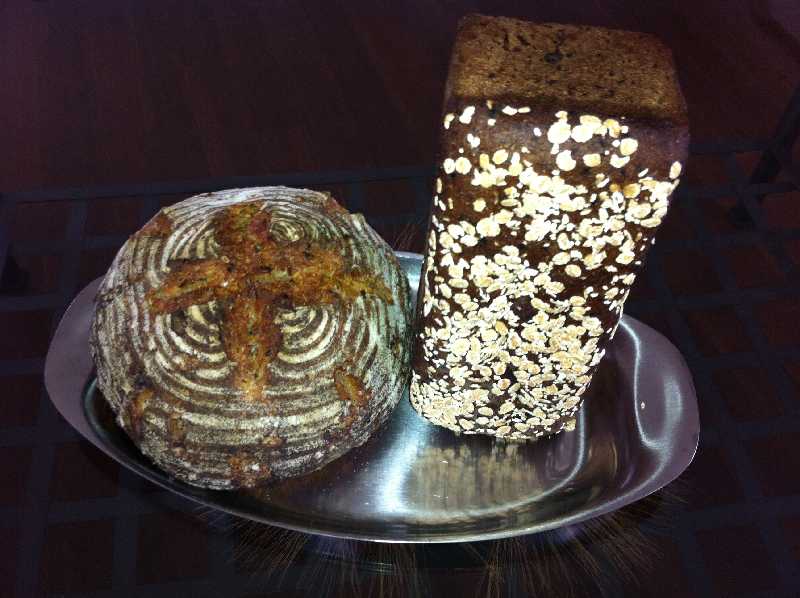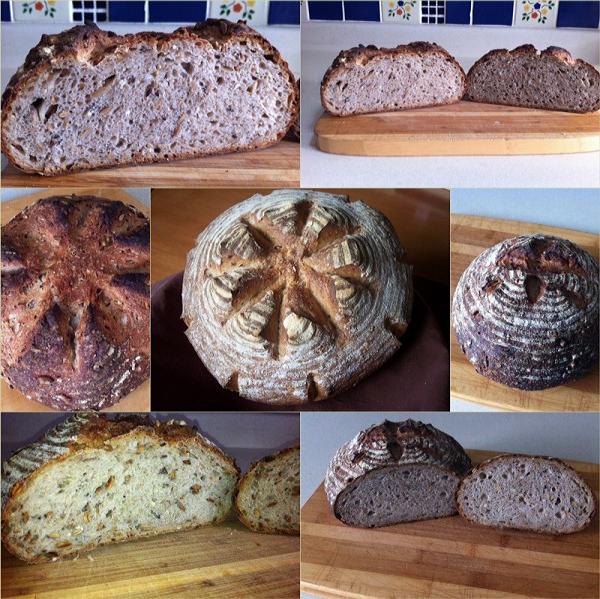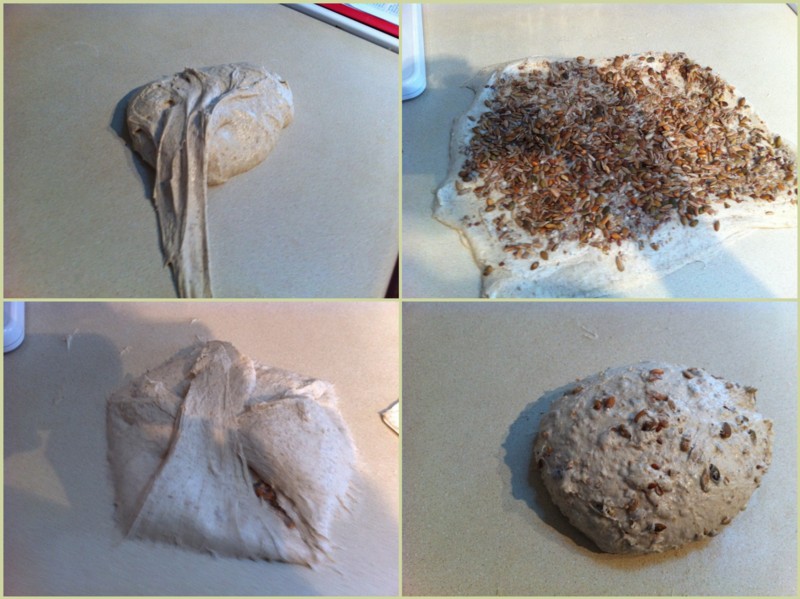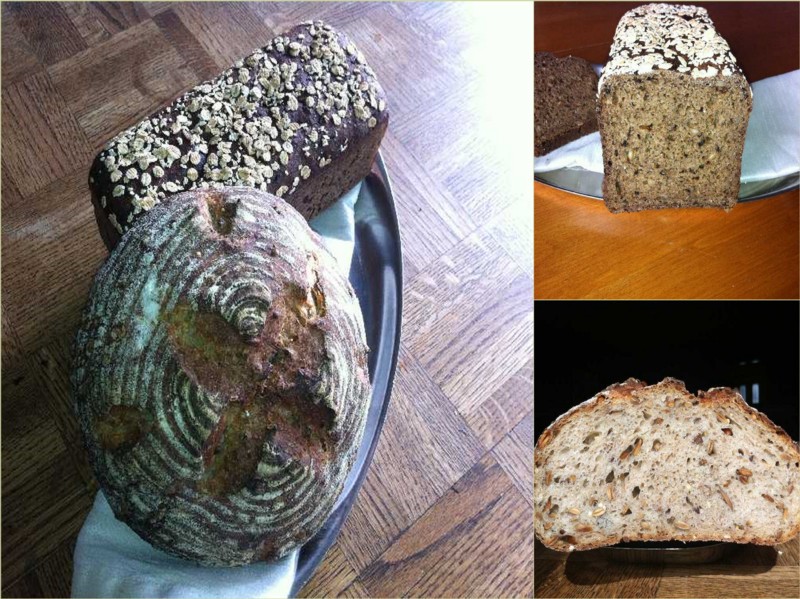
Country Loaf with Mixed Grains & Seeds
It took a little while, but eventually I got tired of eating the same bread week after week for my sandwiches and decided to change things up a bit. For over 3 months my 'go to' bread had been a Country Style Bread/Pan de Campagne that I adapted from Chad Robertson's 'Tartine Country Bread' back in November of last year and posted on in early January of this year. http://www.thefreshloaf.com/node/26796/january-bakingpane-de-campagne-red-fife-and-rye-barley-mash-loaf A very good bread, but enough is enough.
By adding a 7 grain soaker, some toasted sunflower and pumpkin seeds, and an extra flour (barley) to the Pan de Campagne formula, I came up with something I hoped would have the same reliability as the Pane de Campagne, but with additional body and flavour. With a bit of tweaking in the first two mixes the third bake resulted in what I'd imagined from the beginning,which was a crumb that would stay relatively moist and chewy from the first slice to the last. The high hydration in this formula is a major factor in this of course, but I discovered that the final dough weight and how my oven works is a big part of the equation as well. After experimenting with different dough sizes, it became clear that the sweet spot for my oven and the type of texture I was after resulted from doughs weighing between 900-1000 grams. The shorter bake time that I can get away with on the smaller size loaves leaves just the right amount of moisture in the crumb to give it a good chew and mouth-feel. The texture alone makes it a very satisfying bread to eat, with the mixed grains and toasted seeds adding plenty of flavour to the mild/medium sour background. The bread is quite filling, so I tend to slice it on the thin side, finding that a 900 gram loaf will meet my needs for an entire week of sandwiches and often a bit more.

This is a very wet and sticky to work with during the initial development stage, but it does get easier to handle after the first of it's 3 stretch and folds. If you can avoid the temptation of dusting it down with additional flour, and work it through a few minutes of slap & fold to a medium development, the payoff in the final result is worth the effort.

Although the dough could be mixed, fermented and baked in a day, for convenience sake I do the primary 3 hour bulk fermentation in the Brod & Taylor proofer, then round the dough loosely and put it in the fridge for anywhere up to 20 hours before it's final shaping, proof, and bake. All the mixes I've made of this bread have performed reliably, resulting in a full flavoured loaf with good eating and keeping qualities, putting it high on my short list of everyday breads.
Procedure for: Country Loaf with Mixed Grains & Seeds
Levain
Mix 1/2 of the AP flour and remaining ingredients for levain and ripen for 12-15 hours @ 70F/21C, feeding at midway point with the remaining AP flour.
Final dough:
DDT-76-78F/24-25C
Autolyse the flours and water for 1 hour.
Mix all ingredients except the salt, soaker and toasted seeds on 1st speed for 3-4 minutes until dough is uniformly smooth. Add the salt and continue mixing for 7-8 minutes on 2nd speed until the dough has come together, although it will only show slight development. Scrape the dough from the bowl to an unfloured or very lightly floured surface and work the dough using the slap and fold technique for 4-5 minutes, or until you notice the dough beginning to tighten and become moderately developed. Important not to develop past this stage for best results in the baked loaf. Press the dough out to a disk and spread the seed soaker and toasted seeds evenly across the dough. Fold the sides of the dough over the seeds and gently work them into the dough with a kneading action until evenly distributed.
Bulk ferment at 76-78F/24-25C for 3 hours giving 3 stretch and folds at 60,120 and 150 minutes. After the last S&F relax the dough on the table for 30 minutes then round loosely and put in a bowl and cover with plastic. Place the dough in refrigerator over night, or for up to 20 hours. Remove from fridge and leave the dough to sit at room temp for 45 minutes.
Whether shaping as a batard or boule, shape as tightly as possible without tearing the dough. Place in a floured banneton or brotform or free shape, then transfer to a proofing box.
Final rise of 2-2 1/2 hours @ 78F/25C, or until slightly less than fully proofed.
Place on a parchment covered peel, score as desired, and bake in a preheated 500F/260C oven with stone, using preferred steaming method.
Reduce oven heat to 460F/237C after 10 minutes, remove the steaming apparatus, vent the steam and continue baking for 20 minutes, rotating the loaf periodically for even colouring. Check the colour and reduce the heat if necessary, baking to an internal temperature of 208-210F/97-112. * Note* heavier loaves of 1200 grams or more will require longer secondary baking times.
Turn the oven off, prop the door open slightly and leave the loaf in the oven for 10-15 minutes to cool gradually.
Wrap the loaf in linen and place on a wire rack for 12 hours or longer before slicing.

Rye & Barley Mash Loaf- revised
The day before I baked the Mixed Grain & Seed loaf, I did a second bake of the Rye & Barley Mash Loaf that I first posted on in the link above, something I've been meaning to do since eating the last slice of this delicious bread. I love this bread for its assertive, complex, and long lasting flavour, the way it makes the house smell as it's baking, and that it's a pleasure to eat just as is, without toppings. With this latest mix I made two changes to the formula by adding a dark chocolate coloured barley malt and increasing the overall hydration. I haven't noticed any significant difference in the flavour from the added malt, but it did give the loaf a darker colour that I feel it needed. The increased hydration was to see if it would help open the crumb a bit more than the last loaf, which it did to some extent. The loaf had 48 hours rest before the first slice was taken but the crumb was still very moist, not gummy, but not fully set either. Two more changes are in order for the next bake of this bread, the first will be to bake it for a longer time at a lower temperature to see if that will help with the crumb set-up, and for better caramelization. The second change will be to use the largest Pullman tin I have for all future bakes, considering how quickly this bread seems to disappear. Just as size was an important factor in the Mixed Grain & Seed loaf, so it is with this bread, albeit for entirely different reasons.
Links to revised procedure and spreadsheet formula for Rye and Barley Mash Loaf below.
For procedure click here For formula spreadsheet click here
Cheers,
Franko
- Franko's Blog
- Log in or register to post comments
Excellent post Franko!
Your results speak for themselves. I will have to give these loaves a try in the near future. I enjoy working with wet doughs and love the moist open crumb you get with a soaker/mash technique.
I appreciate your charts as well.
Ian
Hi Ian,
Thanks very much for your comments! If you enjoy working with wet doughs you'll certainly be in your element with these two. Glad you like the charts, thanks again.
Franko
Excellent post and lovely photos.
Thanks for sharing,
Howard
Thanks Howard!
My poor old Kodak digital finally packed it in so I had to use my iPhone cam for these shots. It's a darn good cam but takes a bit of practice to get the colours to look right. The crumb shot of the Rye Barley isn't exactly accurate but as close as I could get with the light at the time.
Franko
Beautiful loaves! It sounds delicious.
Nice write-up of your process, both the procedure and your thought process.
David
Thank you David!
Your compliments on the breads, and particularly the write-up are greatly appreciated. I've always admired your write-up style and clarity of process, so hopefully I was able to channel some of that into this one.
Franko
The entire post is excellent...repeating, Howard : ) Thanks for taking the time to share. I've tried to consume similar seeded loaves and have also found that less can be more when it comes to the size of the slices and boule.
Sylvia
Thank you so much Sylvia, glad you enjoyed the post! :^)
A little bit of the Mixed Grain loaf goes a long way with me when it's used for sandwiches. I actually prefer not having the thicker slices I'd normally have using an unseeded or single grain bread.
Franko
The rye and barley mash one just seems so incredibly appealing. I want to make it just so I can get a taste of those flavors. Great that you stuck with one long enough to get sick of it. And looks like you have only gone up from there with your new loaf. -Varda
Hi Varda,
The Rye Barley loaf has amazing flavour that I'm sure you would enjoy. I'm not sure how it would compare to a Borodinsky as I haven't managed to have anything remotely close to your own success with that bread, but there might be some flavour similarities. Many thanks for your kind comments!
Franko
Hi Franko,
A high rye loaf with barley, and a levain with grains and seeds! Two beautiful breads which you showcase so well.
Great post; great breads!
All good wishes
Andy
Hi Andy,
I took particular note of the rye paste consistency when I was mixing the Rye Barley, looking for how I could use that information for a second attempt at the Borodinsky. Like your Bacheldre Rye, the Anita's Rye used in this mix was extremely thirsty. I'm wondering now if my idea of making the Borodinsky as a hand molded loaf is viable or not considering how loose this paste was. Time will tell. Thanks for your generous comments on the breads and post!
All the best,
Franko
Hi Franko, Your crusty, seeded levain loaves must taste so good, and what a lovely collection of photos.
The contrast between the light barley flakes and dark crust of your barley-rye loaf is just beautiful!
:^) breadsong
Hi breadsong,
Nice to hear that you enjoyed the photos of the breads! I was considering getting a new camera to replace my old one, but I'm fairly happy with the results from the IPhone cam, so maybe I shouldn't bother. Always a pleasure to hear from you breadsong and thanks so much for your great comments! :^)
Franko
Success! This bread you made looks perfect.. Your cumulative expertise as a pro baker really did pay off, Franko!
Thanks Khalid!
Room for improvement yet, but I certainly appreciate your appraisal. Having my hands stuck in doughs for as long as I have on the job definitely helps, but the no-time doughs made in our shop are nothing like the kinds of breads we see on TFL. I've learned more about the craft of baking 'real' bread from folks like you in the 2+ years of being on TFL, than I have in my career as a supermarket baker.
Best wishes,
Franko
Hi Franko, a wonderful miche. May I ask how long the crumb remains moist? Drying out is not a problem with a certain kind of breads... but this bright stuff always seems to require a heavy toll.
Lately I've been mixing high percentage rye breads with high gluten flour. A totally different experience, the dough doesn't even require slap and fold. Did you consider using HG flour for this dough?
NIco
Hi Nico,
When I make a 900-950 gram size loaf of the Mixed Grain, the moisture level stays well within the 'pleasant eating' range for 6-7 days, by which time it's all been eaten. I got really tired of throwing out heels of bread that had gone too dry on me, so this was one of the main goals for this bread.
I have used HG flour in high percentage ryes in the past, and had tremendous volume from the dough. Unfortunately it gave the crumb an almost rubbery texture that wasn't acceptable. It was a bulk buy and have no idea what the properties were, but suspect it was meant for bread machines or as a dietary supplement. I've found that the Canadian AP flour available locally gives the right amount of structure to a high rye without sacrificing the eating quality.
Good to hear from you Nico, your comments and compliments are greatly appreciated as always!
Franko
Hi Franko, thanks for the feedback.
More than for the volume I was suggesting HG flour for dough manageability (I hope I didn't misspell the term). Do you think that a 12 hour retardation would remove the problem and yield a soft crumb? I have a gut feeling that retarding a high percentage rye bread could do more harm than good, but not having ever made it I'm searching an informed opinion.
Nico
Hi Nico,
I wish I could answer that one Nico, but I haven't tried an extended retardation with a high rye, with or without HG. With the HG that I have used I have my doubts the crumb would have softened much, if at all. It might be worth testing though. Maybe on my next mix of the Rye Barley loaf I'll make a little extra and mix a small final dough using HG and leave it overnight to see what happens. The biggest problem with that is remembering to do it when the time comes, but I'll leave myself a note on the formula just in case.
Franko
Franko! Love the crumb on your country seeded loaf and the barley mash bread sounds great. Stellar stuff :)
Many thanks for your very generous comments FlourChild!